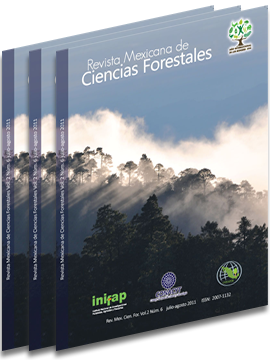MICROPROPAGACIÓN DE Turbinicarpus knuthianus (Boed.) John & Riha CACTACEA ORNAMENTAL DEL DESIERTO CHIHUAHUENSE, EN ESTATUS DE RIESGO
DOI:
https://doi.org/10.29298/rmcf.v2i6.573Palabras clave:
BA–N6-benzyladenina, cactáceas, inoculación de Azospirillum brasilense, medio Murashige y Skoog, micropropagación, Turbinicarpus knuthianusResumen
Se desarrolló un protocolo en cuatro etapas para la micropropagación de Turbinicarpus knuthianus, una cactácea en estatus de riesgo, para la obtención de plantas de maceta con tamaño comercial uniforme, en cantidades suficientes y con calidad fitosanitaria. El método de propagación propuesto es eficiente comparado con el tradicional; es una nueva tecnología de producción factible de aplicarse en el sistema-producto ornamental, bajo el esquema de laboratorio-invernadero. Las semillas de esta especie son quiescentes y pueden establecerse in vitro en el medio MS al 50%, adicionado con 8.65 mM de AG3, con un porcentaje de germinación de 75%. La inducción de brotes se logró a partir de segmentos de hipocotilo, como explantes, en medio de cultivo MS con diferentes tratamientos. Se determinó que el tipo y concentración de fitohormona influyen en la tasa de multiplicación, y generan hasta 10 brotes por explante; la cinetina (KIN) en interacción 10:1 con AIB en baja concentración es la promotora de este efecto. Durante la aclimatación se observó que la aplicación de 1.5 x 106 UFC ml-1 de Azospirillum brasilense tiene un efecto positivo en el proceso rizogénico, de tal manera que se forman hasta 6 raíces por planta con 2.5 cm de longitud. Con esta metodología es posible regenerar especies en estatus de riesgo de importancia ecológica para el Desierto Chihuahuense y se optimizan los procesos biológicos para la producción de plantas de ornato.
Descargas
Descargas
Publicado
Cómo citar
Número
Sección
Licencia
Los autores que publiquen en la Revista Mexicana de Ciencias Forestales aceptan las siguientes condiciones:
De acuerdo con la legislación de derechos de autor, la Revista Mexicana de Ciencias Forestales reconoce y respeta el derecho moral de los autores, así como la titularidad del derecho patrimonial, el cual será cedido a la revista para su difusión en acceso abierto.
Todos los textos publicados por la Revista Mexicana de Ciencias Forestales –sin excepción– se distribuyen amparados bajo la licenciaCreative Commons 4.0 Atribución-No Comercial (CC BY-NC 4.0 Internacional), que permite a terceros utilizar lo publicado siempre que mencionen la autoría del trabajo y a la primera publicación en esta revista. (no permite el uso comercial)
Los autores pueden realizar otros acuerdos contractuales independientes y adicionales para la distribución no exclusiva de la versión del artículo publicado en la Revista Mexicana de Ciencias Forestales (por ejemplo, incluirlo en un repositorio institucional o darlo a conocer en otros medios en papel o electrónicos) siempre que indique clara y explícitamente que el trabajo se publicó por primera vez en la Revista Mexicana de Ciencias Forestales.
Para todo lo anterior, los autores deben remitir el formato de carta-cesión de la propiedad de los derechos de la primera publicación debidamente requisitado y firmado por los autores/as. Este formato debe ser remitido en archivo PDF al correo: editorial.forestal@inifap.gob.mx
Esta obra está bajo una licencia de Creative Commons Reconocimiento-No Comercial 4.0 Internacional.







